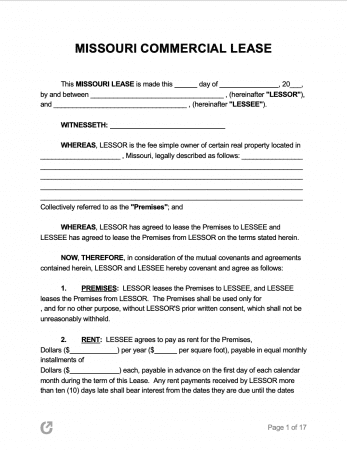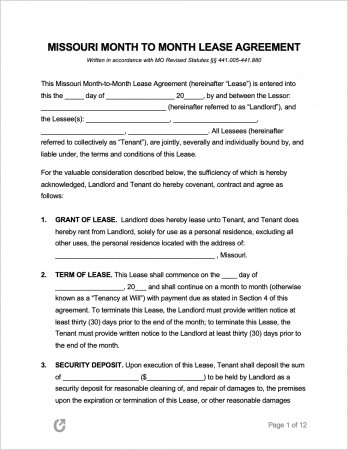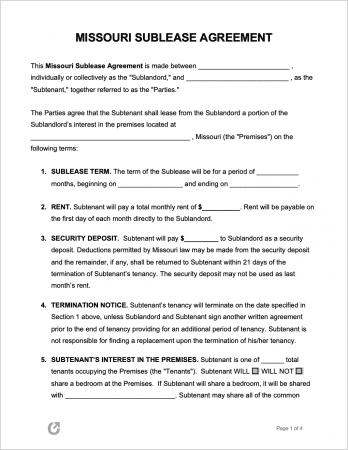Missouri Rental Lease Agreement Templates
The Missouri Rental Lease Agreements are forms that can be downloaded and completed by landlords for the purpose of forming a binding agreement over the rental of real estate. “Binding” refers to both parties’ legal obligation to staying compliant with all conditions included in the form, such as the stated rent, required utility payments, mandated notices, policies on guests, and much more. With leases, it is important landlords stay compliant with both federal, state, and local ordinances and statutes, which the forms found below provide.
Types (6)
 Commercial Lease Agreement – Sets binding conditions over the rental of business-zoned property to restaurants, offices, warehouses, retail stores, and more.
Commercial Lease Agreement – Sets binding conditions over the rental of business-zoned property to restaurants, offices, warehouses, retail stores, and more.
Download – Adobe PDF, Word (.docx)
 Lease to Own Agreement – Also referred to as a “Lease-Option Contract”, the agreement serves as a standard lease with the additional option of allowing the tenants to purchase the rented property for an agreed-upon price.
Lease to Own Agreement – Also referred to as a “Lease-Option Contract”, the agreement serves as a standard lease with the additional option of allowing the tenants to purchase the rented property for an agreed-upon price.
Download – Adobe PDF, Word (.docx)
 Month-to-Month Lease Agreement – A lease that renews automatically after each month, provided that neither party terminates.
Month-to-Month Lease Agreement – A lease that renews automatically after each month, provided that neither party terminates.
Download – Adobe PDF, Word (.docx)
 Roommate Agreement – A contract that roommates sign with the intention of clarifying any and all matters relevant to daily tasks, guests, belongings, payments, and more.
Roommate Agreement – A contract that roommates sign with the intention of clarifying any and all matters relevant to daily tasks, guests, belongings, payments, and more.
Download – Adobe PDF, Word (.docx), Rich Text (.rtf)
 Standard Residential Lease Agreement – Compliant with MO law, the form is the most commonly used for renting out apartment units, homes, rooms, condominiums, and more.
Standard Residential Lease Agreement – Compliant with MO law, the form is the most commonly used for renting out apartment units, homes, rooms, condominiums, and more.
Download – Adobe PDF, Word (.docx)
 Sublease Agreement – If a tenant will be absent from the rental property for a given amount of time, they can use the document to rent out their leased space while they are gone.
Sublease Agreement – If a tenant will be absent from the rental property for a given amount of time, they can use the document to rent out their leased space while they are gone.
Download – Adobe PDF, Word (.docx)
What is a Missouri Lease Agreement?
A Missouri Lease Agreement is a document that requires signees—a landlord and tenant—to hold themselves accountable to the terms they mutually agreed upon. Failing to do so may result in financial or legal consequences. To prevent a situation where the tenant fails to meet their legal responsibilities, landlords should make sure to vet prospective tenants. The best way to do this is by requiring prospective tenants to complete a rental application.
State Laws & Guides
Laws
Landlord-Tenant Guides / Handbooks
When is Rent Due?
State law does not specify the timeframe rent must be paid by. There is also no grace period specified by state law. It is thus important that all information pertaining to rent is clarified in the written lease.
Landlord’s Access
Emergency: No statute; state law is silent on matters relating to a landlord’s ability to access a rental dwelling in the event of an emergency. However, under federal law, landlords have a right to enter without notice in such situations.
Non-Emergency: No statute; landlords are advised to provide tenants with sufficient notice before entering rented dwellings (24 hours minimum).
Tenant’s Duties
Missouri Statute 441.630 specifies that occupants (tenants) have the following duties:
- Dispose of all trash in a safe manner;
- Use electrical, heating, and plumbing fixtures reasonably;
- Comply with all obligations imposed by the code enforcement agency and/or the community;
- Refrain from destroying or damaging the rental property (and common areas);
- Not sublease or introduce additional tenants without clear approval from the landlord.
Required Disclosures
- Prior Methamphetamine Production Disclosure (§ 441.236): If a rental unit/property was used as a site for methamphetamine production, the landlord must disclose said information to the prospective lessee in writing. This should be disclosed regardless of whether the persons involved in the production were convicted or not.
- Lead Paint Disclosure: Per federal law, landlords must disclose any known lead paint hazards in rental dwellings built before 1978. Tenants must also be furnished with a lead paint safety pamphlet.
- Name and Addresses (§ 535.185): Landlords must provide tenants the name(s) and address(es) of the person(s) authorized to manage the rental as well as the individual whom all notices and other documents should be sent to.
Security Deposits
Maximum (§ 535.300): Security deposits are capped at two (2) months’ rent.
Returning to Tenant (§ 535.300): The security deposit must be returned to the tenant within thirty (30) days after the termination of the tenancy. If the landlord will withhold part or all of the deposit, they must furnish the tenant with a written itemized list of the damages the tenant has caused.
Deposit Interest (§ 535.300): All interest that accrues on security deposit is the property of the landlord.
Uses of the Deposit (§ 535.300(4)): Landlords can make deductions from the security deposit for the following reasons:
- To cover unpaid rent,
- To return the rental unit to the condition it was in upon the tenant’s move-in. Standard wear and tear is not included.
- To recover damages that resulted from the tenant terminating the lease without the necessary notice required by law and/or the lease agreement.
